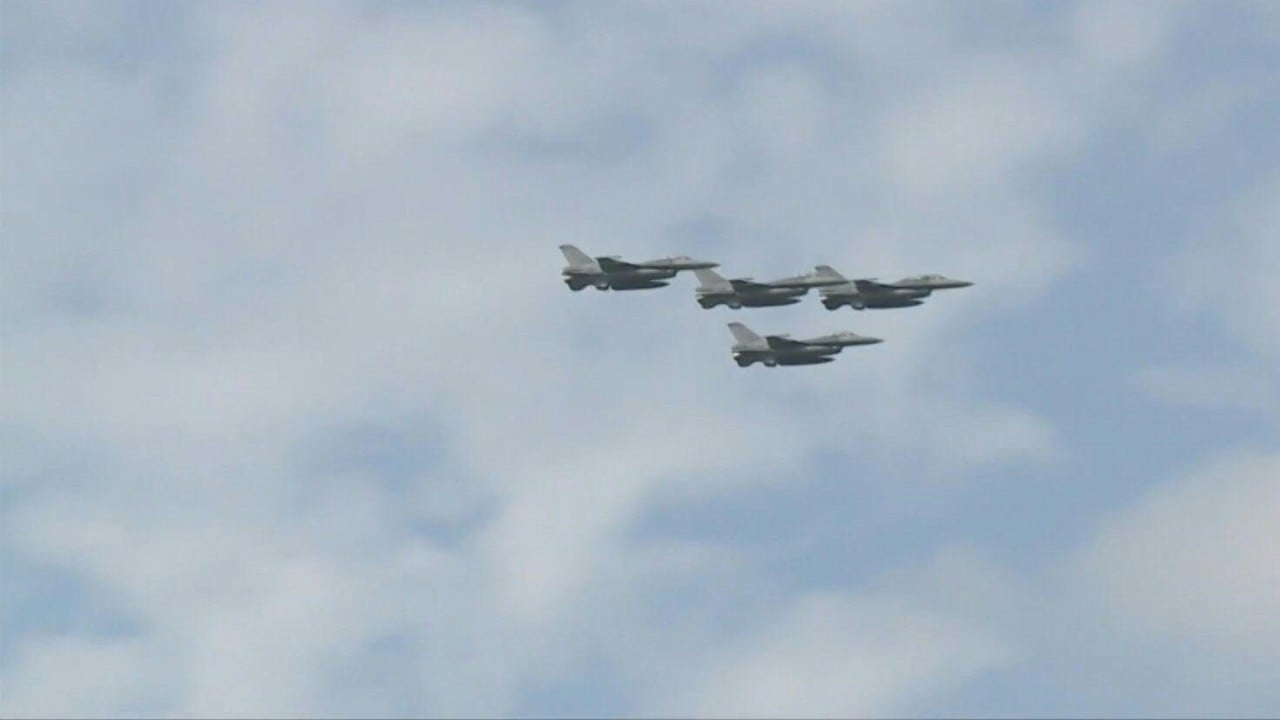
01:15
Taiwan deploys its most advanced F-16V fighter jets amid rising military tensions with Beijing

The crash of one of Taiwan’s most advanced fighter jets during a routine drill on Tuesday points to problems with pilot training and fatigue from responding to repeated sorties by the PLA, analysts said.
The F-16V jet crashed into waters east of Taiwan soon after take-off from Chiayi Air Force Base, according to the island’s air force.
Searchers have recovered some wreckage of the aircraft’s fuselage but the pilot, 28-year-old Captain Chen Yi, is still missing.
The crash occurred during a drill to simulate a high-speed dive bombing air-to-ground attack, a challenging element of training for less-experienced pilots.
An initial investigation indicated that Chen had switched on the speaker key during the flight, blocking his communication with air command. Some military observers and air force veterans suggested he had mistaken the button as a slow-down key, according to Taiwanese media.
The F-16V is an upgraded version of the US-made F-16A/B fighter jet and this is the 10th accident since the air force took delivery of 150 of the initial versions in 1997. The air force has grounded the fleet for inspection.
The upgraded “V” aircraft went into service in November, equipped with new weapons and flight control systems, but the island’s pilot training programme and standards might not have kept pace, Andrei Chang, editor-in-chief of the Canada-based Kanwa Defence Review said.
“The upgrades to the F-16V are very advanced and mean the aircraft are not suitable for basic training like the air-to-ground simulated drill,” Chang said, adding that the People’s Liberation Army had suggested that it used virtual reality technology to train young pilots.
“The Taiwanese air force needs to adjust its training programme and standards to keep pace with the mainland.”
Chen, the missing pilot, had more than 300 hours of flight time, including 60 hours in the F-16V, according to the air force.
Lu Li-Shih, a former instructor at Taiwan’s Naval Academy, said that in the past, Taiwanese air force cadet pilots would not undertake such a drill until they had more than 100 hours of flight time. But less experienced pilots were having to step up.
“The accident should be blamed on the lack of pilots available to meet the demands of the growing number of fighter jets Taipei plans to buy from the United States – young pilots are being pushed to step up training,” Lu said.
He said cadet pilots were flying older generation aircraft like the F-5Es, which had very different flight control systems to the advanced F-16s, and young pilots needed more training to make the transition.
In addition to retrofitting the F-16A/Bs, the Taiwanese air force has ordered 66 new F-16Vs to bolster defences. Delivery of the jets, in a deal worth US$8 billion, is expected to start next year.
Ben Ho, an air power researcher from the military studies programme at the S Rajaratnam School of International Studies in Singapore, said that while the avionics and sensors of the F-16Vs were new, the airframes dated to the late 1990s.
“Ageing aircraft need more and specialised maintenance to be airworthy,” Ho said.
Ho said the increasing tempo of the PLA’s “encirclement flights” around Taiwan in the past year could have exhausted the island’s air force crews, making them lower the level of maintenance.
“[Tuesday’s crash] is the sixth incident in the past two years, and this could reflect systemic issues within the [Taiwanese air force],” he said.
“With the latest crash and the subsequent grounding of [Taiwan’s] entire F-16 fleet, it is likely that the PLA will step up its encirclement flights to put even more pressure on an already embattled Taiwanese military.”
PLA aircraft flew more than 950 sorties across the Taiwan Strait in 2021 – compared with 380 in the whole of 2020, pushing the Taiwanese air force to scramble fighter jets for monitoring and expulsion, according to the island’s defence ministry.
“The PLA made 950 sorties of incursion, with some coming at midnight, which means the Taiwan air force needed to send more fighters to deal with them,” Lu said.
Macau-based military observer Antony Wong Tong said the crash showed Beijing’s war of attrition to exhaust the Taiwanese air force was having an impact.